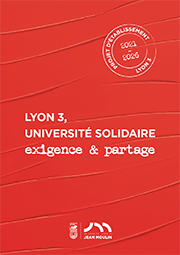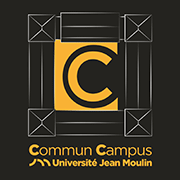AccueilRechercheLes productions scientifiquesThèsesThèses soutenuesThèses soutenues - 2006-2020Thèses soutenues - 2012
-
Partager cette page
- Recherche,
ZHAO Wei
Une réflexion sur le concept de "développement" à travers le cas de la cieille ville de Lijang (RPC).
Publié le 12 juillet 2012 – Mis à jour le 28 août 2012
Thèse en études transculturelles soutenue le 29 Juin 2012 en cotutelle avec l'Université Centrale des Nationalités à Pékin.
Comment est-ce que les villes anciennes parviennent à se réinséser dans des ensembles urbains?Quels roles les diverses populations en présence jouent-elles dans les phénomènes de recomposition de ces espaces locaux?Est-ce qu’il n’y a que une route de development au monde qui s’appelle mondialisation?
C’est à questions sensibles que s’efforce de répondre ce thèse en proposant une analyse minutieuse des multiples processus qui est fonçonné, au cour des dernières vingtaine ans en Chine, la transformation de culture et tradition du Lijiang, situé dans la province de Yunnan, à la marge en Chine. En retraçant ainsi au fil du temps la vie de ce lieu et ses habitants, ce thèse veut entraine dans l’histoire récente en Chine, en meme temps métider la route de development local et le concept de ‘développement’.
Géneralement, mon thèse est divisé en trois parties. D’abord, je vais presenter l’histoire de Lijiang. Le comté de Li Jiang se situe dans le nord-ouest du Yunnan, au sud-est du plateau Tibétain. C’est un région antonome de Naxi et elle représente la fusion harmonieuse de différentes traditions culturelles qui engendreront un paysage urbain d'une qualité exceptionnelle. Son architecture est remarquable par l'association d'éléments de plusieurs cultures réunies durant de nombreux siècles. Lijiang possède également un système d'alimentation en eau extrêmement complexe et ingénieux qui fonctionne toujours efficacement. Tout ça s’aident classer au Patrimoine mondial de l'UNESCO en 1997. Depuis 1997, la ville ancienne sont beaucoup moins marquées qu’au cours de mondialisation par des mutations spectaculaires, liées à accroissement de leur population et à l’extension (ou à la densification) de leur territoire. Beaucoup de gens vennent à Li Jiang pourchasser son rave de trésor, donc les personnes locales sont separés leur région natale et habitent dehors de la vieille ville. La tradition culturelle est changé rapidement. L’atmosphère de Commerce est la courant principale de cette ville. C’est à dire, elle est perdu sa identité dans une large mesure.
Dans la secondaire partie, j’essaye de présenter l’histoire développée de Vieux-lyon pour au contraire de Lijiang. Forte de ses 2000 ans d'histoire, Lyon a conservé des traces de ses différentes phases de développement, ses quartiers ont donc chacun gardé un patrimoine riche et diversifié avec de nombreux musées qui reflètent les particularités et les richesses historiques de la cité. Lyon est classée, depuis 1998, au patrimoine mondial de l’UNESCO. Cette patrie s’accompagne d’une presentation de réhabitation de Vieux-Lyon qui est associée aux processus de traitement des quartiers anciens postérieures à 1967, et en particulier aux opérations programmées d’amélioration de l’habitat (OPAH). J’espere que je pourrai tirer leçon du experience de Vieux-lyon dans la sociéte contemporaine pour developer mieux à Lijiang.
À la fin, c’est mon analysis sur la base de cette recherche comparative. La réforme et l’ouverture sur le monde extérieur sont exéculté depuis 1978 en Chine, le gouverment s’efforce de developer l’économie. La façon de protéger héritage culture est devenu de plus en plus la manière de developer l’économie. En autre mot, c’est la technique de development dans les lieux locaux et une partie de modernisation (ou mondialisation). Après la guerre mondiale secondaire, modernisation est une trendence principal au monde, par ce thèse, je veux réfléchir sur cette processus de modernisation à nouveau, et analyse la route divisitaire de dévelopment sur la base de les environnements differents. Aujourd’hui, si nous voulons etre inscrits au patrimoine mondial, en un sens, ce n’est pas pour bien le protèger, mais pour profiter de cet honneur et d’un outil pour développer l’économie. Apres etre inscrit au patrimoine mondial, le gouvernement locale a des raisons de demander le support financier au gouvernement central et il a aussi des chances d’attirer les capitaux étrangers pour améliorer les constructions principales.
Lijiang old Town is located in the northwest of Yunnan Province, one of the Naxi settlements. Historically, the ancestors of the Naxi and Tibetan, Han, Yi, Bai and other ethnic have lived together in peace, forming its own unique ecological view, and nourishing their own national character, which makes the town own its unspeakable intangible charm in the long history. In 1997, Lijiang Old Town was in the World Heritage List and enters the fast development track. As the result of economic development, the local Naxi culture gradually changes, for example, the ancient city’s commercial atmosphere increasing strong, the outside population coming, the Naxi language usage among the younger generations becoming less and less, the essence of the Dongba culture to be overlooked etc. Based on the above facts, the author tries to explore the Lijiang Old Town as a case from the perspective of the “anthropology of development”. Through collecting data on the basis of the field, compared with the Old City of Lyon, France, the author criticizes the modernist view of development and the excessive use of tools of cultural heritage, highlights our "development" view and cultural heritage awareness bias. The author believes that "development" should be multiple semantics, not just economic growth, including local knowledge. Fading out the cultural heritage as a tool to develop local economy and we should protect the heritage authenticity and integrity, respect different cultures and traditions, and then achieve scientific development and build a harmonious society.
Based on the above understanding, the author from the perspective of subjective and objective explores the main viewpoints. Besides the introduction and conclusion, the paper consists of three major parts:
In the first part, the author places the town of Lijiang in the scope of a long period of time and space, tracing its history through several important development stages: Tea Horse Road period, the anti-Japanese period in the Second World War and after the inscription. In contrast to the development of the past and today, the author shows some differences from the original Ancient Town’s life to today’s commercial city. In the process, the ancient city has changes from community to modern society, the traditional Naxi culture gradually lost.
The second part explores different thoughts on the changes of this Old Town of Lijiang from the ethnographic perspective. Mainly through the interview to a family history of the Naxi and three generations’ oral storytelling who have lived in the ancient city, as well as city managers, Naxi scholars, community workers in Lijiang Old Town, young Naxi generation, ordinary residents, outsiders, and the author own field experiences and feelings, the author tries to show different understandings of the whole changes from the outside to the inside of Lijiang old Town. On this basis, the author reinterpreted the stereotype of the ancient Naxi people.
In the third part, the author presents the deviation of understanding of the cultural heritage’s protection and development by comparing Lyon Old Town in France. From the “ anthropology of development”, the paper reflects the tool behavior and misunderstanding in the progress of developing and protecting our country’s old city, that is to say, development means not only developing local economy but also protecting tradition culture and customs, etc.
Mots-cléfs : la ville de Lijiang; anthropologie de développement; le patrimoine mondial; Vieux Lyon; groupe ethnique de Naxi; le concept de ‘développement’; réflexion; diversité
Keywords : Lijiang old town; cultural heritage; anthropology of development; diversity; reflection; Lyon old town; ethnic group of Naxi; the concept of ‘development’
Directeur de thèse : Grégory LEE
Zhului YANG
Membres du jury :
Grégory B. LEE, Professeur, Université Jean MOulin Lyon III
Zhuhui YANG, Professeur, Université centrale des nationalités, Pékin
Xiaoyang ZHU, Professeur, Université de Beijing
Haiyang ZHANG, Professeur, Université centrale des nationalités, Pékin
Yanbo GUAN, Chercheur supérieur national, académie sciences sociales de Chine
Florent VILLARD, Maître de conférences, Université Jean Moulin Lyon III
Président du jury : ZHANG Haiyang
Mention : Honorable
Equipe d'accueil : IETT
C’est à questions sensibles que s’efforce de répondre ce thèse en proposant une analyse minutieuse des multiples processus qui est fonçonné, au cour des dernières vingtaine ans en Chine, la transformation de culture et tradition du Lijiang, situé dans la province de Yunnan, à la marge en Chine. En retraçant ainsi au fil du temps la vie de ce lieu et ses habitants, ce thèse veut entraine dans l’histoire récente en Chine, en meme temps métider la route de development local et le concept de ‘développement’.
Géneralement, mon thèse est divisé en trois parties. D’abord, je vais presenter l’histoire de Lijiang. Le comté de Li Jiang se situe dans le nord-ouest du Yunnan, au sud-est du plateau Tibétain. C’est un région antonome de Naxi et elle représente la fusion harmonieuse de différentes traditions culturelles qui engendreront un paysage urbain d'une qualité exceptionnelle. Son architecture est remarquable par l'association d'éléments de plusieurs cultures réunies durant de nombreux siècles. Lijiang possède également un système d'alimentation en eau extrêmement complexe et ingénieux qui fonctionne toujours efficacement. Tout ça s’aident classer au Patrimoine mondial de l'UNESCO en 1997. Depuis 1997, la ville ancienne sont beaucoup moins marquées qu’au cours de mondialisation par des mutations spectaculaires, liées à accroissement de leur population et à l’extension (ou à la densification) de leur territoire. Beaucoup de gens vennent à Li Jiang pourchasser son rave de trésor, donc les personnes locales sont separés leur région natale et habitent dehors de la vieille ville. La tradition culturelle est changé rapidement. L’atmosphère de Commerce est la courant principale de cette ville. C’est à dire, elle est perdu sa identité dans une large mesure.
Dans la secondaire partie, j’essaye de présenter l’histoire développée de Vieux-lyon pour au contraire de Lijiang. Forte de ses 2000 ans d'histoire, Lyon a conservé des traces de ses différentes phases de développement, ses quartiers ont donc chacun gardé un patrimoine riche et diversifié avec de nombreux musées qui reflètent les particularités et les richesses historiques de la cité. Lyon est classée, depuis 1998, au patrimoine mondial de l’UNESCO. Cette patrie s’accompagne d’une presentation de réhabitation de Vieux-Lyon qui est associée aux processus de traitement des quartiers anciens postérieures à 1967, et en particulier aux opérations programmées d’amélioration de l’habitat (OPAH). J’espere que je pourrai tirer leçon du experience de Vieux-lyon dans la sociéte contemporaine pour developer mieux à Lijiang.
À la fin, c’est mon analysis sur la base de cette recherche comparative. La réforme et l’ouverture sur le monde extérieur sont exéculté depuis 1978 en Chine, le gouverment s’efforce de developer l’économie. La façon de protéger héritage culture est devenu de plus en plus la manière de developer l’économie. En autre mot, c’est la technique de development dans les lieux locaux et une partie de modernisation (ou mondialisation). Après la guerre mondiale secondaire, modernisation est une trendence principal au monde, par ce thèse, je veux réfléchir sur cette processus de modernisation à nouveau, et analyse la route divisitaire de dévelopment sur la base de les environnements differents. Aujourd’hui, si nous voulons etre inscrits au patrimoine mondial, en un sens, ce n’est pas pour bien le protèger, mais pour profiter de cet honneur et d’un outil pour développer l’économie. Apres etre inscrit au patrimoine mondial, le gouvernement locale a des raisons de demander le support financier au gouvernement central et il a aussi des chances d’attirer les capitaux étrangers pour améliorer les constructions principales.
Lijiang old Town is located in the northwest of Yunnan Province, one of the Naxi settlements. Historically, the ancestors of the Naxi and Tibetan, Han, Yi, Bai and other ethnic have lived together in peace, forming its own unique ecological view, and nourishing their own national character, which makes the town own its unspeakable intangible charm in the long history. In 1997, Lijiang Old Town was in the World Heritage List and enters the fast development track. As the result of economic development, the local Naxi culture gradually changes, for example, the ancient city’s commercial atmosphere increasing strong, the outside population coming, the Naxi language usage among the younger generations becoming less and less, the essence of the Dongba culture to be overlooked etc. Based on the above facts, the author tries to explore the Lijiang Old Town as a case from the perspective of the “anthropology of development”. Through collecting data on the basis of the field, compared with the Old City of Lyon, France, the author criticizes the modernist view of development and the excessive use of tools of cultural heritage, highlights our "development" view and cultural heritage awareness bias. The author believes that "development" should be multiple semantics, not just economic growth, including local knowledge. Fading out the cultural heritage as a tool to develop local economy and we should protect the heritage authenticity and integrity, respect different cultures and traditions, and then achieve scientific development and build a harmonious society.
Based on the above understanding, the author from the perspective of subjective and objective explores the main viewpoints. Besides the introduction and conclusion, the paper consists of three major parts:
In the first part, the author places the town of Lijiang in the scope of a long period of time and space, tracing its history through several important development stages: Tea Horse Road period, the anti-Japanese period in the Second World War and after the inscription. In contrast to the development of the past and today, the author shows some differences from the original Ancient Town’s life to today’s commercial city. In the process, the ancient city has changes from community to modern society, the traditional Naxi culture gradually lost.
The second part explores different thoughts on the changes of this Old Town of Lijiang from the ethnographic perspective. Mainly through the interview to a family history of the Naxi and three generations’ oral storytelling who have lived in the ancient city, as well as city managers, Naxi scholars, community workers in Lijiang Old Town, young Naxi generation, ordinary residents, outsiders, and the author own field experiences and feelings, the author tries to show different understandings of the whole changes from the outside to the inside of Lijiang old Town. On this basis, the author reinterpreted the stereotype of the ancient Naxi people.
In the third part, the author presents the deviation of understanding of the cultural heritage’s protection and development by comparing Lyon Old Town in France. From the “ anthropology of development”, the paper reflects the tool behavior and misunderstanding in the progress of developing and protecting our country’s old city, that is to say, development means not only developing local economy but also protecting tradition culture and customs, etc.
Mots-cléfs : la ville de Lijiang; anthropologie de développement; le patrimoine mondial; Vieux Lyon; groupe ethnique de Naxi; le concept de ‘développement’; réflexion; diversité
Keywords : Lijiang old town; cultural heritage; anthropology of development; diversity; reflection; Lyon old town; ethnic group of Naxi; the concept of ‘development’
Directeur de thèse : Grégory LEE
Zhului YANG
Membres du jury :
Grégory B. LEE, Professeur, Université Jean MOulin Lyon III
Zhuhui YANG, Professeur, Université centrale des nationalités, Pékin
Xiaoyang ZHU, Professeur, Université de Beijing
Haiyang ZHANG, Professeur, Université centrale des nationalités, Pékin
Yanbo GUAN, Chercheur supérieur national, académie sciences sociales de Chine
Florent VILLARD, Maître de conférences, Université Jean Moulin Lyon III
Président du jury : ZHANG Haiyang
Mention : Honorable
Equipe d'accueil : IETT
Documentation
Mise à jour : 28 août 2012



